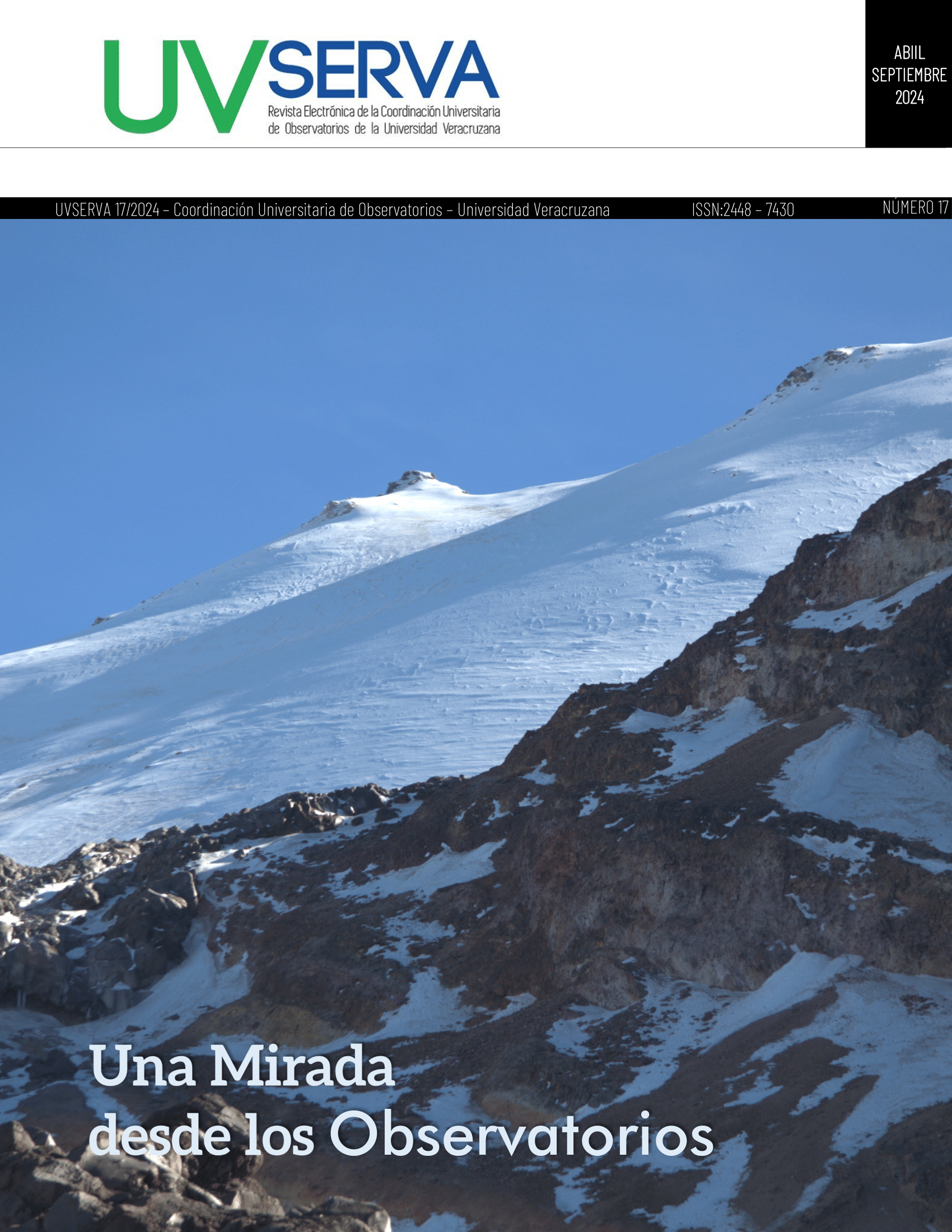Abstract
Small-volume volcanoes are the most abundant in Mexico and worldwide, and tend to cluster in space (volcanic fields). Here, spatial point pattern techniques are applied to compare the behavior of the spatial intensity of the Sierra Chichinautzin and Los Tuxtlas volcanic fields. Spatial intensities are fitted with inhomogeneous Poisson process models. Subsequently, a permutations test with Monte Carlo simulation is applied and a test statistic based on the likelihood ratio of the fitted models is proposed. The results of the permutations test delivered evidence to reject the hypothesis of equality of spatial intensities between the volcanic fields of Sierra Chichinautzin and Los Tuxtlas. The intercept of the fitted model of the Los Tuxtlas volcanic field estimates an intensity (volcanoes per unit area) of 0.42 while the intercept of the fitted model of the intensity of the Sierra Chichinautzin volcanic field was 0.40 units. Alternative statistical methods used in the literature are discussed and their usefulness to answer questions in volcanology are compared.
References
Baddeley, A., Rubak, E. y Turner, R. (2015). Spatial point patterns: methodology and applications with R. CRC Press.
Baddeley, A., and Turner, R. (2005). Spatstat: An R package for analyzing spatial point patterns.
Bebbington, M. (2009). Volcanic Eruptions: Stochastic Models of Occurrence Patterns. En R. Meyers, (Ed.), Encyclopedia of Complexity and Systems Science. (pp. 9831–9861). Springer. https://doi.org/10.1007/978-0-387-30440-3_580
Becerril, L., Cappello, A., Galindo, I., Neri, M. y Del Negro, C. (2013). Spatial probability distribution of future volcanic eruptions at El Hierro Island (Canary Islands, Spain). Journal of Volcanology and Geothermal Research, 257, 21-30.
Besag, J. y Diggle, P. J. (1977). Simple Monte Carlo tests for spatial pattern. Journal of the Royal Statistical Society Series C: Applied Statistics, 26(3), 327-333.
Boots, B. y Getis, A. (1988). Point Pattern Analysis. En Thrall, G. I. (Ed.), The Web Book of Regional Science (Web version, pp. 8-69). WVU Research Repository.
Cappello, A., Bilotta, G., Neri, M. y Negro, C. (2013). Probabilistic modeling of future volcanic eruptions at Mount Etna. Journal of Geophysical Research: Solid Earth, 118(5), 1925-1935.
Cappello, A., Neri, M., Acocella, V., Gallo, G., Vicari, A. y Del Negro, C. (2012). Spatial vent opening probability map of Etna volcano (Sicily, Italy). Bulletin of Volcanology, 74, 2083-2094.
Connor, C. (1990). Cinder Cone Clustering in the TransMexican Volcanic Belt: Implications for Structural and Petrologic Models. Journal of Geophysical Research: Solid Earth, 95(B12), 1653. https://digitalcommons.usf.edu/geo_facpub/1653
Connor, C., Conway, F. y Sigurdsson, H. (2000). Basaltic volcanic fields. En H. Sigurdsson (Ed.), Encyclopedia of Volcanoes (2a ed., pp. 423-439). Academic Press. Diggle, P. (2013). Statistical analysis of spatial and spatio-temporal point patterns. CRC press.
Diggle, P. J., Mateu, J. y Clough, H. (2000). A comparison between parametric and non-parametric approaches to the analysis of replicated spatial point patterns. Advances in Applied Probability, 32(2), 331-343.
Doob, J. (1990). Stochastic Processes. Wiley.
Ferrari, L., Orozco-Esquivel, T., Manea, V. y Manea, M. (2012). The dynamic history of the Trans-Mexican Volcanic Belt and the Mexico subduction zone. Tectonophysics, 522, 122-149.
Gelfand, A. E., Diggle, P., Guttorp, P. y Fuentes, M. (2010). Handbook of spatial statistics. CRC press.
Good, P. (2013). Permutation tests: a practical guide to resampling methods for testing hypotheses. Springer Science & Business Media.
Hahn, U. (2012). A studentized permutation test for the comparison of spatial point patterns. Journal of the American Statistical Association, 107(498), 754-764.
Ho, C. y Smith, E. (1998). A spatial-temporal/3-D model for volcanic hazard assessment: application to the Yucca Mountain region, Nevada. Mathematical geology, 30, 497-510.
Hopkins, J., Smid, E., Eccles, J., Hayes, J., Hayward, B., McGee, L., Wijk, K., Wilson, T., Cronin, S., Leonard, G., Lindsay, J., Nemeth, K. y Smith, I. (2021). Auckland Volcanic Field magmatism, volcanism, and hazard: a review, New Zealand Journal of Geology and Geophysics, 64(2–3), 213-234. https://doi.org/10.1080/00288306.2020.1736102
Jaimes-Viera, M., Del Pozzo, A., Layer, P., Benowitz, J. y Nieto-Torres, A. (2018). Timing the evolution of a monogenetic volcanic field: Sierra Chichinautzin, Central Mexico. Journal of Volcanology and Geothermal Research, 356, 225-242. https://doi.org/10.1016/j.jvolgeores.2018.03.013
Kambhatla, N. y Leen, T. (1997). Dimension reduction by local principal component analysis. Neural computation, 9(7), 1493-1516. https://doi.org/10.1162/neco.1997.9.7.1493
Le Corvec, N., Spörli, K., Rowland, J. y Lindsay, J. (2013). Spatial distribution and alignments of volcanic centers: clues to the formation of monogenetic volcanic fields. Earth-Science Reviews, 124, 96-114. https://doi.org/10.1016/j.earscirev.2013.05.005
Mazzarini, F., Ferrari, L. y Isola, I. (2010). Self-similar clustering of cinder cones and crust thickness in the Michoacan–Guanajuato and Sierra de Chichinautzin volcanic fields, Trans-Mexican Volcanic Belt. Tectonophysics, 486(1-4), 55-64.
R Core Team (2024). R: A language and environment for statistical computing. R Foundation for Statistical Computing, Vienna, Austria. https://www.R-project.org/
Ripley, B. (1977). Modelling spatial patterns. Journal of the Royal Statistical Society: Series B (Methodological), 39(2), 172-192.
Ripley, B. (1979). Tests of randomness for spatial point patterns. Journal of the Royal Statistical Society: Series B (Methodological), 41(3), 368-374.
Sieron, K., Guilbaud, M., Zarazúa-Carbajal, M. y Juárez-Cerrillo, S. (2023). Monogenetic volcanism in subduction settings: comparative statistical study of the Sierra Chichinautzin and Los Tuxtlas Volcanic Fields in Mexico. Bulletin of Volcanology, 85(2), 14. https://doi.org/10.1007/s00445-023-01625-4
Sieron, K., Juárez Cerrillo, S., González-Zuccolotto, K., Córdoba-Montiel, F., Connor, C., Connor, L. y Tapia-McClung, H. (2021). Morphology and distribution of monogenetic volcanoes in Los Tuxtlas Volcanic Field, Veracruz, Mexico: implications for hazard assessment. Bulletin of Volcanology, 83(7), 47. https://doi.org/10.1007/s00445-021-01467-y
Steele, J. (2001). Stochastic calculus and financial applications (Vol. 1). Springer.
Wackerly, D., Mendenhall III, W. y Scheaffer, R. (2002). Estadística matemática con aplicaciones. Cengage Learning.

This work is licensed under a Creative Commons Attribution-NonCommercial 4.0 International License.
Copyright (c) 2023 Francisco Córdoba Montiel

